
Defi nitions: Safety Guidelines
The definitions below describe the level of severity for each signal word. Please read the
manual and pay attention to these symbols.
DANGER: Indicates an imminently hazardous situation which, if not avoided, will
result in death or serious injury.
WARNING: Indicates a potentially hazardous situation which, if not avoided, could
result in death or serious injury.
CAUTION: Indicates a potentially hazardous situation which, if not avoided, may result
in minor or moderate injury.
NOTICE: Indicates a practice not related to personal injury which, if not avoided, may
result in property damage.
IF YOU HAVE ANY QUESTIONS OR COMMENTS ABOUT THIS OR ANY DEWALT TOOL, CALL
US TOLL FREE AT: 1-800-4-D
EWALT (1-800-433-9258).
WARNING: To reduce the risk of injury, read the instruction manual.
General Power Tool Safety Warnings
WARNING! Read all safety warnings and all instructions. Failure to follow the
warnings and instructions may result in electric shock, fire and/or serious injury.
SAVE ALL WARNINGS AND INSTRUCTIONS
FOR FUTURE REFERENCE
The term “power tool” in the warnings refers to your mains-operated (corded) power tool or
battery-operated (cordless) power tool.
1) WORK AREA SAFETY
a) Keep work area clean and well lit. Cluttered or dark areas invite accidents.
b) Do not operate power tools in explosive atmospheres, such as in the presence
of flammable liquids, gases or dust. Power tools create sparks which may ignite the
dust or fumes.
c) Keep children and bystanders away while operating a power tool. Distractions can
cause you to lose control.
2) ELECTRICAL SAFETY
a) Power tool plugs must match the outlet. Never modify the plug in any way. Do
not use any adapter plugs with earthed (grounded) power tools. Unmodified plugs
and matching outlets will reduce risk of electric shock.
b) Avoid body contact with earthed or grounded surfaces such as pipes, radiators,
ranges and refrigerators. There is an increased risk of electric shock if your body is
earthed or grounded.
c) Do not expose power tools to rain or wet conditions. Water entering a power tool
will increase the risk of electric shock.
d) Do not abuse the cord. Never use the cord for carrying, pulling or unplugging
the power tool. Keep cord away from heat, oil, sharp edges or moving parts.
Damaged or entangled cords increase the risk of electric shock.
e) When operating a power tool outdoors, use an extension cord suitable for
outdoor use. Use of a cord suitable for outdoor use reduces the risk of electric shock.
f) If operating a power tool in a damp location is unavoidable, use a ground fault
circuit interrupter (GFCI) protected supply. Use of a GFCI reduces the risk of electric
shock.
3) PERSONAL SAFETY
a) Stay alert, watch what you are doing and use common sense when operating a
power tool. Do not use a power tool while you are tired or under the influence
of drugs, alcohol or medication. A moment of inattention while operating power tools
may result in serious personal injury.
b) Use personal protective equipment. Always wear eye protection. Protective
equipment such as dust mask, non-skid safety shoes, hard hat, or hearing protection
used for appropriate conditions will reduce personal injuries.
c) Prevent unintentional starting. Ensure the switch is in the off position before
connecting to power source and/or battery pack, picking up or carrying the tool.
Carrying power tools with your finger on the switch or energizing power tools that have
the switch on invites accidents.
d) Remove any adjusting key or wrench before turning the power tool on. A wrench
or a key left attached to a rotating part of the power tool may result in personal injury.
e) Do not overreach. Keep proper footing and balance at all times. This enables better
control of the power tool in unexpected situations.
f) Dress properly. Do not wear loose clothing or jewelry. Keep your hair, clothing
and gloves away from moving parts. Loose clothes, jewelry or long hair can be caught
in moving parts.
g) If devices are provided for the connection of dust extraction and collection
facilities, ensure these are connected and properly used. Use of dust collection can
reduce dust-related hazards.
4) POWER TOOL USE AND CARE
a) Do not force the power tool. Use the correct power tool for your application. The
correct power tool will do the job better and safer at the rate for which it was designed.
b) Do not use the power tool if the switch does not turn it on and off. Any power tool
that cannot be controlled with the switch is dangerous and must be repaired.
c) Disconnect the plug from the power source and/or the battery pack from the
power tool before making any adjustments, changing accessories, or storing
power tools. Such preventive safety measures reduce the risk of starting the power tool
accidentally.
d) Store idle power tools out of the reach of children and do not allow persons
unfamiliar with the power tool or these instructions to operate the power tool.
Power tools are dangerous in the hands of untrained users.
e) Maintain power tools. Check for misalignment or binding of moving parts,
breakage of parts and any other condition that may affect the power tool’s
operation. If damaged, have the power tool repaired before use. Many accidents
are caused by poorly maintained power tools.
f) Keep cutting tools sharp and clean. Properly maintained cutting tools with sharp
cutting edges are less likely to bind and are easier to control.
g)
Use the power tool, accessories and tool bits, etc. in accordance with these
instructions, taking into account the working conditions and the work to be
performed. Use of the power tool for operations different from those intended could
result in a hazardous situation.
5) SERVICE
a) Have your power tool serviced by a qualified repair person using only identical
replacement parts. This will ensure that the safety of the power tool is maintained.
Additional Safety Rules for Routers
• Hold power tool by insulated gripping surfaces because the cutter may contact its
own cord. Cutting a “live” wire may make exposed metal parts of the tool “live” and shock
the operator.
• Use clamps or another practical way to secure and support the workpiece to a
stable platform. Holding the work by your hand or against the body leaves it unstable and
may lead to loss of control.
• Metal cutting with router: If using router for metal cutting, clean out tool often.
Metal dust and chips often accumulate on interior surfaces and could create a risk of serious
injury, electrical shock or death.
• Never run the motor unit when it is not inserted in one of the router bases. The motor
is not designed to be handheld.
• Keep handles dry, clean and free from oil and grease. This will enable better control of
the tool.
• Maintain a firm grip with both hands on the tool to resist starting torque. Maintain a
firm grip on the tool at all times while operating.
INSTRUCTION MANUAL
GUIDE D’UTILISATION
MANUAL DE INSTRUCCIONES
DW616, DW618
Router System
Système de toupie
Sistema de rebajadora
INSTRUCTIVO DE OPERACIÓN, CENTROS DE SERVICIO Y
PÓLIZA DE GARANTÍA.
ADVERTENCIA: LÉASE ESTE
INSTRUCTIVO ANTES DE USAR EL PRODUCTO.
DEWALT Industrial Tool Co., 701 East Joppa Road, Towson, MD 21286
(APR14) Part No. N384518 DW616, DW618 Copyright © 2003, 2005, 2012, 2014 D
EWALT
The following are trademarks for one or more DEWALT power tools: the yellow and black color scheme, the “D” shaped
air intake grill, the array of pyramids on the handgrip, the kit box configuration, and the array of lozenge-shaped humps on
the surface of the tool.
• Keep hands away from cutting area above and below the base. Never reach under
the workpiece for any reason. Keep the router base firmly in contact with the workpiece
when cutting.
• Never touch the bit immediately after use. It may be extremely hot.
• Be sure that the motor has stopped completely before you lay the router down. If
the bit is still spinning when the tool is laid down, it could cause injury or damage.
• Be sure that the router bit is clear of the workpiece before starting the motor. If the
bit is in contact with the workpiece when the motor starts, it could make the router jump,
causing damage or injury.
• Always follow the bit manufacturer’s speed recommendations as some bit designs
require specific speeds for safety or performance. If you are unsure of the proper
speed or are experiencing any type of problem, contact the bit manufacturer.
• Do not use router bits with a diameter in excess of 2-1/2" (63 mm) in this tool.
• Do not hand-hold the router in an upside-down or horizontal position. The motor can
separate from the base if not properly attached according to the instructions.
• Before starting the motor, check to see that the cord will not snag or impede the
routing operation.
• Keep cutting pressure constant. Do not overload motor.
• Provide clearance under workpiece for bit when through-cutting.
• Do not press spindle lock button while the motor is running. Doing so can damage
the spindle lock.
• Always make sure the work surface is free from nails and other foreign objects.
Cutting into a nail can cause the bit and the tool to jump.
• Air vents often cover moving parts and should be avoided. Loose clothes, jewelry or
long hair can be caught in moving parts.
• An extension cord must have adequate wire size (AWG or American Wire Gauge)
for safety. The smaller the gauge number of the wire, the greater the capacity of the cable,
that is 16 gauge has more capacity than 18 gauge. An undersized cord will cause a drop in
line voltage resulting in loss of power and overheating. When using more than one extension
to make up the total length, be sure each individual extension contains at least the minimum
wire size. The following table shows the correct size to use depending on cord length and
nameplate ampere rating. If in doubt, use the next heavier gauge. The smaller the gauge
number, the heavier the cord.
Minimum Gauge for Cord Sets
Ampere Rating
Volts Total Length of Cord in Feet (meters)
120V 25 (7.6) 50 (15.2) 100 (30.5) 150 (45.7)
240V 50 (15.2) 100 (30.5) 200 (61.0) 300 (91.4)
More
Than
Not More
Than
AWG
0 6 18 16 16 14
610 18161412
10 12 16 16 14 12
12 16 14 12 Not Recommended
WARNING: ALWAYS use safety glasses. Everyday eyeglasses are NOT safety glasses.
Also use face or dust mask if cutting operation is dusty. ALWAYS WEAR CERTIFIED SAFETY
EQUIPMENT:
• ANSI Z87.1 eye protection (CAN/CSA Z94.3),
• ANSI S12.6 (S3.19) hearing protection,
• NIOSH/OSHA/MSHA respiratory protection.
WARNING: Some dust created by power sanding, sawing, grinding, drilling, and other
construction activities contains chemicals known to the State of California to cause cancer, birth
defects or other reproductive harm. Some examples of these chemicals are:
• lead from lead-based paints,
• crystalline silica from bricks and cement and other masonry products, and
• arsenic and chromium from chemically-treated lumber.
Your risk from these exposures varies, depending on how often you do this type of work.
To reduce your exposure to these chemicals: work in a well ventilated area, and work with
approved safety equipment, such as those dust masks that are specially designed to filter out
microscopic particles.
• Avoid prolonged contact with dust from power sanding, sawing, grinding, drilling,
and other construction activities. Wear protective clothing and wash exposed areas
with soap and water. Allowing dust to get into your mouth, eyes, or lay on the skin may
promote absorption of harmful chemicals.
WARNING: Use of this tool can generate and/or disperse dust, which may cause serious and
permanent respiratory or other injury. Always use NIOSH/OSHA approved respiratory protection
appropriate for the dust exposure. Direct particles away from face and body.
WARNING: Always wear proper personal hearing protection that conforms to ANSI
S12.6 (S3.19) during use. Under some conditions and duration of use, noise from this product
may contribute to hearing loss.
• The label on your tool may include the following symbols. The symbols and their definitions
are as follows
V .....................volts A .........................amperes
Hz ...................hertz W ........................watts
min .................minutes
or AC .............alternating current
or DC .....direct current or AC/DC......alternating or direct current
...................Class I Construction
n
o .......................no load speed
(grounded) n .........................rated speed
................... Class II Construction .......................earthing terminal
(double insulated)
........................safety alert symbol
…/min ............per minute BPM ...................beats per minute
IPM .................impacts per minute RPM ...................revolutions per minute
SPM ...............strokes per minute sfpm ...................surface feet per minute
SAVE THESE INSTRUCTIONS FOR FUTURE USE
Motor
Be sure your power supply agrees with the nameplate marking. Voltage decrease of more than
10% will cause loss of power and overheating. D
EWALT tools are factory tested; if this tool does
not operate, check power supply.
COMPONENTS (Fig. 1)
WARNING: Never modify the power tool or any part of it. Damage or personal injury could
result.
A. Quick release latch
B. Depth adjustment ring
C. Adjustable scale
D. Locking lever
E. Knob handle
F. Subbase
G. Speed dial (DW618 only)
H. Guide pin groove
I. Spindle lock button (DW618 only)
J. Collet nut
K. Toggle switch
L. Detachable cordset
M. Holes for universal edge guide
N. D-handle trigger switch
O. Trigger lock button
P. Turret stop
Q. Depth adjustment rod
R. Plunge lock lever
S. Dust shroud
T. Dust cap
U. D-Handle
INTENDED USE
This heavy-duty router is designed for professional routing applications.
DO NOT use under wet conditions or in presence of flammable liquids or gases.
This is a professional power tool. DO NOT let children come into contact with the tool.
Supervision is required when inexperienced operators use this tool.
Switch (Fig. 1)
To turn the tool on, push the toggle switch (K) to the ON position indicated on the tool. To turn
the tool off, push the toggle switch to the OFF position indicated on the tool.
Detachable Cord Set (Fig. 1A)
WARNING: To reduce the risk of injury, turn unit off and disconnect it from power
source before installing and removing cord set from motor or D-handle base. Before
connecting cord set to power source, ensure the toggle switch (K) and the D-handle trigger
switch (N) are in the OFF position. An accidental start-up can cause injury.
Insert the detachable cordset plug so that the key (W) is aligned with the notch (V) in the
socket. Turn the plug clockwise one quarter turn to lock.
OPERATION
WARNING: To reduce the risk of injury, turn unit off and disconnect it from power
source before installing and removing accessories, before adjusting or when making
repairs. An accidental start-up can cause injury.
WARNING: Before connecting cord set to power source, ensure the toggle switch
(K) and the D-handle trigger switch (N) are in the OFF position. An accidental start-up
can cause injury.
WARNING: Before starting the tool, clear the work area of all foreign objects. Check to see
that the cord will not snag or impede the routing operation. Also keep firm grip on tool to resist
starting torque.
General for All Bases
LOCKING LEVER ADJUSTMENT (FIG. 4)
You should be able to clamp the locking lever without excessive force. Excessive force may
damage the base.
You should not be able to move the motor in the base when the locking lever is clamped. To
adjust the locking lever’s clamping force, open the locking lever (D) and turn the nut (Y) in small
increments. Turning the nut clockwise tightens the lever while turning the nut counterclockwise
loosens the lever.
CENTERING THE SUBBASE (FIG. 5)
If you need to adjust, change, or replace the subbase, a centering tool (DNP617–sold separately)
is recommended (refer to Accessories). The centering tool consists of a cone and a pin.
To adjust the subbase, follow the steps below
1. Loosen but do not remove the subbase screws so that the subbase can move freely.
2. Insert the pin into the collet and tighten the collet nut.
3. Insert the motor into the base and clamp the locking lever on the base.
4. Place the cone on the pin and lightly press down on cone until it stops as shown. This will
center the subbase.
5. While holding down on the cone, tighten the subbase screws.
BIT INSTALLATION AND REMOVAL (FIG. 6)
1. To install a bit, insert the round shank of the de sired router bit into the loosen ed collet as far
as it will go and then pull it out about 1/16" (1.6 mm). Using the wrench(es) provided, turn
the collet nut (J) clockwise while holding the spindle shaft with the second wrench. [On the
DW618, depress the spindle lock button (I) to hold the spindle shaft.] Tighten the collet nut
securely to prevent the bit from slipping.
2. To remove a bit, hold the spindle shaft while turning the collet nut (J) counterclockwise with
the wrench provided. [Hold the spindle by depressing the spindle lock button (I) on the
DW618.] The self-releasing collet nut will turn approximately 3/4 of a turn and then become
tight again. At this point the bit cannot be re moved. Continue turning the collet nut counter-
clock wise. This lifts the collet, allowing the bit’s removal.
COLLETS
WARNING: Projectile hazard. Only use bits with shanks that match the installed
collet. Smaller shank bits will not be secure and could become loose during operation.
CAUTION: Never tighten the collet without first installing a router bit in it. Tightening an empty
collet, even by hand, can damage the collet.
If you have questions or comments, contact us.
Pour toute question ou tout commentaire, nous contacter.
Si tiene dudas o comentarios, contáctenos.
1-800-4-DEWALT • www.dewalt.com

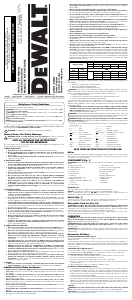


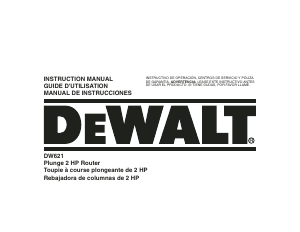


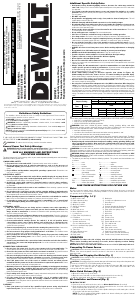
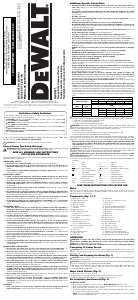
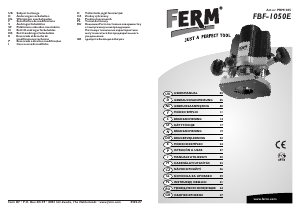
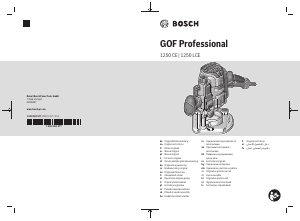
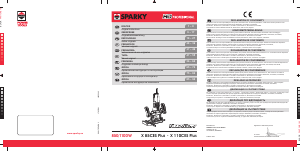
Únase a la conversación sobre este producto
Aquí puedes compartir lo que piensas sobre DeWalt DW616 Fresadora de superficie. Si tiene alguna pregunta, primero lea atentamente el manual. Puede solicitar un manual utilizando nuestro formulario de contacto.